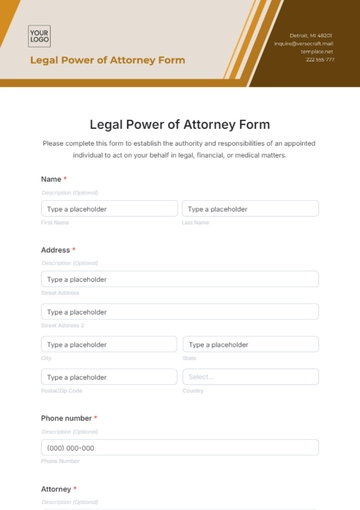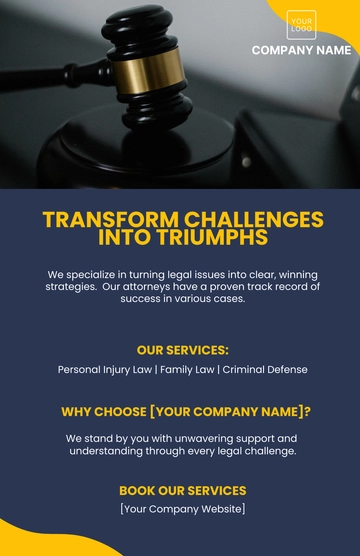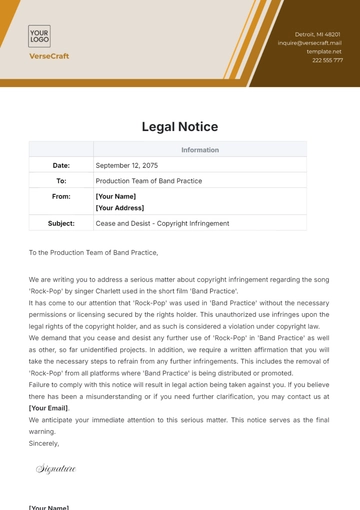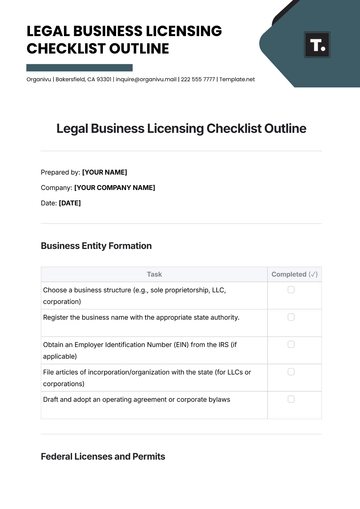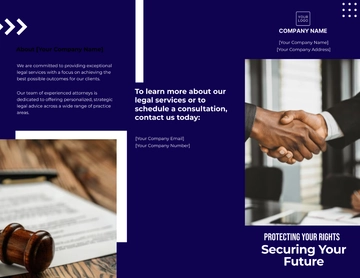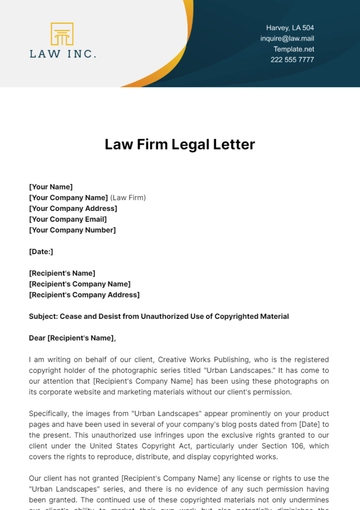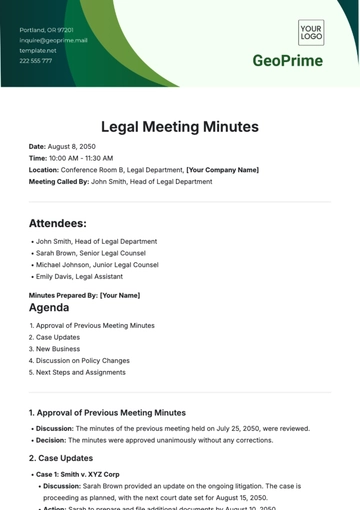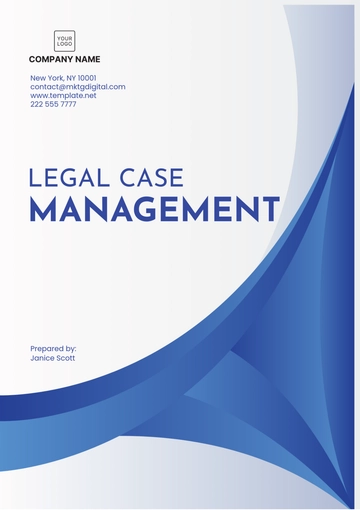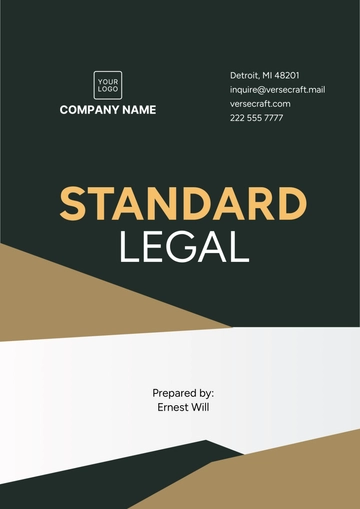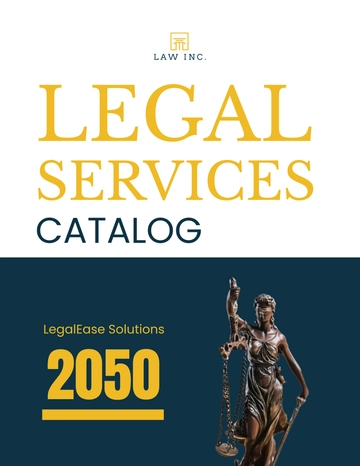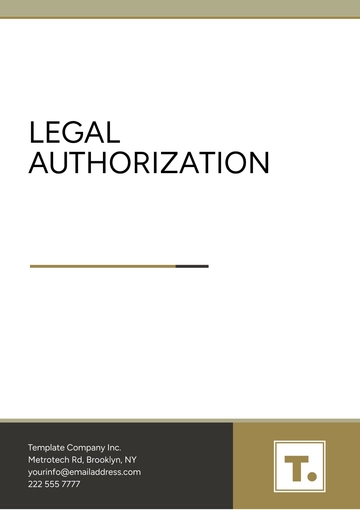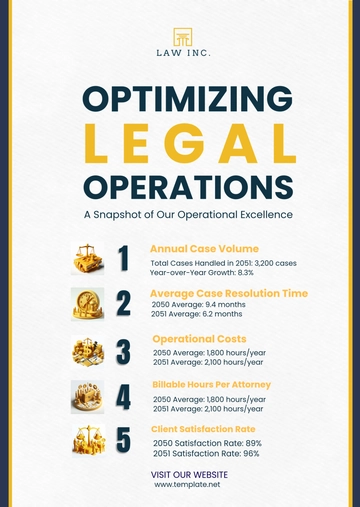Free Law Firm Client Retention Strategy

I. Introduction
A. Purpose of the Plan
Client Satisfaction: The primary purpose of this plan is to improve client satisfaction. By understanding and effectively addressing the needs of our clients, we aim to enhance their experience with us. This involves not only meeting their legal needs but also providing them with exceptional service that exceeds their expectations.
Client Retention: A key objective of this plan is to increase client retention rates. We believe that by providing excellent service and building strong relationships with our clients, we can encourage them to continue using our services. This not only benefits our clients but also contributes to the growth and success of the firm.
Reputation Enhancement: This plan also aims to enhance our reputation in the legal industry. By delivering high-quality service and achieving high client satisfaction and retention rates, we can establish ourselves as a leading law firm in the industry.
Revenue Increase: Another important purpose of this plan is to increase revenue through repeat business from satisfied clients. By retaining our clients and meeting their legal needs effectively, we can ensure a steady stream of revenue for the firm.
Competitive Advantage: Lastly, this plan aims to create a competitive advantage for us. By setting ourselves apart from other law firms in terms of client service and satisfaction, we can position [Your Company Name] as the preferred choice for legal services.
B. Expected Outcomes
Increased Client Satisfaction: By implementing this plan, we expect to see an increase in client satisfaction. Satisfied clients are more likely to continue using our services and are more likely to refer others to us, contributing to the growth of the firm.
Higher Client Retention Rates: As a result of the strategies outlined in this plan, we anticipate an increase in client retention rates. Retaining clients is not only beneficial for our clients but also for the firm as it ensures a steady stream of revenue and reduces the cost of acquiring new clients.
Enhanced Reputation: With the successful implementation of this plan, we expect to see an enhancement in our reputation in the legal industry. High client satisfaction and retention rates will position us as a leading law firm, attracting more clients and further growing our business.
Increased Revenue: This plan is also expected to lead to an increase in revenue for the firm. Repeat business from satisfied clients will contribute to a steady stream of revenue. Additionally, high client retention rates mean lower client acquisition costs, further increasing our profitability.
Competitive Advantage: Finally, this plan will help us create a competitive advantage. By providing exceptional service and meeting our clients’ needs effectively, we can set ourselves apart from other law firms. This will make us the preferred choice for legal services, further enhancing our market position.
II. Understanding Client Needs
Understanding the needs of our clients is the first and most crucial step in our client retention strategy. It forms the foundation upon which all our other strategies are built.
A. Client Surveys
Regular Surveys: We will conduct regular online surveys to gather feedback from our clients. These surveys will be designed to gauge client satisfaction and identify areas where we can improve. By conducting these surveys regularly, we can track our progress over time and make adjustments as necessary.
Survey Analysis: The feedback from these surveys will be thoroughly analyzed to extract meaningful insights. This analysis will help us understand what we are doing well and where we need to improve. It will also help us identify trends and patterns that can inform our future strategies.
Action on Feedback: The insights gained from the surveys will not just be used for understanding our clients’ needs, but will also be acted upon. We will use this feedback to make necessary changes in our services and operations to better meet our clients’ needs and expectations. This shows our clients that we value their feedback and are committed to improving their experience with us.
Communication of Changes: Any changes made based on the survey feedback will be communicated back to our clients. This will show them that their feedback is valued and has a direct impact on our services. It also keeps them informed about how we are working to improve their experience with us.
Continuous Improvement: The process of conducting surveys, analyzing feedback, making changes, and communicating these changes will be a continuous one. This ensures that our understanding of our clients’ needs is always up-to-date and our services are continually improving.
B. Client Interviews
In-Person Interviews: In addition to surveys, we will also conduct in-person interviews with key clients. These interviews will allow us to gain deeper insights into their specific needs and expectations. They also provide an opportunity for our clients to share their experiences and suggestions in a more detailed and personal manner.
Tailored Services: The insights gained from these interviews will be used to tailor our services to meet the specific needs of each client. This personalized approach not only improves client satisfaction but also strengthens our relationship with them.
Feedback Loop: Just like with the surveys, the feedback from the interviews will be acted upon and the changes communicated back to the clients. This feedback loop shows our clients that their opinions matter and that we are committed to providing them with the best possible service.
Building Relationships: Conducting these interviews also helps us build stronger relationships with our clients. It shows them that we value their input and are willing to take the time to understand their needs on a deeper level. This can lead to increased client loyalty and retention.
C. Client Profiling
In order to effectively meet the needs of our clients, it’s crucial to understand who they are. This involves creating detailed profiles of our typical clients, including their characteristics and their corresponding legal needs. The following table provides the profile of our clients:
Client Characteristics | Corresponding Legal Needs |
|---|---|
Small Business Owners | Legal advice on business laws, contracts, and disputes |
Individuals | Legal advice on personal matters such as family law, estate planning, etc. |
Corporations | Legal advice on corporate laws, mergers and acquisitions, etc. |
Understanding our clients in this way allows us to tailor our services to meet their specific needs. It ensures that we are providing the most relevant and effective legal advice, which in turn increases client satisfaction and retention.
Small Business Owners: These clients typically need legal advice on business laws, contracts, and disputes. They may need help with drafting and reviewing contracts, resolving business disputes, or navigating complex business laws. Our goal is to provide them with clear, practical legal advice that helps them run their businesses more effectively.
Individuals: These clients might need legal advice on a variety of personal matters such as family law, estate planning, etc. They value attorneys who can empathize with their situation and provide compassionate, personalized service. Our aim is to guide them through their legal issues with as little stress as possible, helping them to achieve the best possible outcome.
Corporations: These clients often require legal advice on corporate laws, mergers and acquisitions, etc. They value attorneys who have a deep understanding of their industry and can provide strategic advice that aligns with their business goals. Our goal is to become trusted advisors who contribute to their success.
Furthermore, client profiling is not a one-time task but an ongoing process. As we continue to work with our clients, we will inevitably learn more about them. This new information should be used to update our client profiles, ensuring that they remain accurate and up-to-date. This will allow us to continue meeting our clients’ evolving needs, further enhancing their satisfaction and loyalty.
III. Communication Strategy
Effective communication is a cornerstone of our client retention strategy. It ensures that our clients are always informed and feel valued.
A. Regular Updates
Frequency of Updates: We will provide regular updates to our clients about the progress of their cases. These updates will be scheduled at consistent intervals, ensuring that our clients are always in the loop. Regular updates not only keep our clients informed but also show them that we are actively working on their behalf.
Methods of Communication: These updates will be delivered through the client’s preferred method of communication, whether that’s email, phone calls, or in-person meetings. By respecting our clients’ preferences, we can ensure that our communication is both effective and convenient for them.
Content of Updates: The updates will include information about the progress of the case, any changes that may affect the outcome, and the next steps in the process. By providing comprehensive updates, we can ensure that our clients fully understand their situation and feel confident in our services.
Response to Queries: In addition to providing updates, we will also promptly respond to any queries or concerns our clients may have. This shows our clients that we value their input and are committed to addressing their needs.
Transparency: All our communication will be transparent, ensuring that our clients have a clear understanding of their case and our services. Transparency builds trust, which is crucial for client retention.
B. Transparency
Openness about Outcomes: We will be open and honest with our clients about potential outcomes of their cases. This includes discussing the best-case, worst-case, and most likely scenarios. This helps manage our clients’ expectations and builds trust.
Discussion of Risks: We will also discuss any potential risks or challenges that might arise during the course of the case. This allows our clients to be prepared for any eventualities and ensures that there are no unpleasant surprises.
Clarity about Costs: We will provide clear and detailed information about our fees and the potential costs involved in the case. This includes providing an estimate at the start of the case and updating it as necessary. Transparency about costs ensures that our clients feel that they are getting value for their money and helps build trust.
Regular Reviews: We will conduct regular reviews of our cases with our clients. This gives us an opportunity to discuss the progress of the case, address any concerns, and adjust our strategy if necessary. Regular reviews ensure that our clients are involved in the process and feel that their voices are heard.
Confidentiality: We will maintain strict confidentiality in all our communications with our clients. This ensures that our clients feel safe sharing sensitive information with us, which is crucial for building trust and maintaining a strong attorney-client relationship.
C. Client Meetings
Scheduling Meetings: We will schedule regular meetings with our clients to discuss their cases. These meetings provide an opportunity for in-depth discussion and allow us to address any concerns our clients may have.
Preparation for Meetings: Before each meeting, we will prepare a clear agenda and ensure that we have all the necessary information at hand. This ensures that our meetings are productive and valuable for our clients.
Follow-up after Meetings: After each meeting, we will provide our clients with a summary of what was discussed and the next steps. This helps ensure that our clients are clear about the progress of their case and what to expect moving forward.
Flexibility: We understand that our clients have busy schedules, so we will offer flexible meeting times and options for remote meetings. This ensures that our clients can communicate with us at a time and in a manner that is convenient for them.
Respect for Time: We respect our clients’ time and will strive to start and end our meetings on time. We will also ensure that our meetings are focused and efficient, covering all necessary points without unnecessary delays.
Open Communication: We encourage our clients to ask questions and share their concerns during our meetings. We believe that open communication is key to understanding our clients’ needs and providing them with the best possible service.
IV. Client Service Improvement
Improving our service to clients is a key part of our client retention strategy. It involves providing regular training for our staff, implementing a system for receiving and acting on client feedback, and establishing clear service standards.
A. Training
Regular Training Sessions: We will conduct regular training sessions for all our staff members. These sessions will cover a range of topics, from legal knowledge to client service skills. By providing regular training, we can ensure that our staff are always up-to-date with the latest legal developments and are equipped to provide the best possible service to our clients.
Tailored Training Programs: Our training programs will be tailored to the needs of our staff and our clients. This means that the content of the training will vary depending on the role of the staff member and the needs of our clients. For example, our lawyers might receive training on the latest legal developments, while our client service team might receive training on communication and relationship-building skills.
Continuous Learning Culture: We aim to foster a culture of continuous learning within our firm. This means that learning and development will be a regular part of our operations, not just something that happens during formal training sessions. We will encourage our staff to continuously improve their skills and knowledge, and provide them with the resources and support they need to do so.
Evaluation of Training Effectiveness: We will regularly evaluate the effectiveness of our training programs. This will involve gathering feedback from our staff, observing changes in their performance, and assessing the impact of the training on our client satisfaction and retention rates. The results of these evaluations will be used to continuously improve our training programs.
Commitment to Excellence: Our commitment to regular training reflects our commitment to excellence. We believe that by investing in the development of our staff, we can provide superior service to our clients and set ourselves apart from other law firms.
B. Feedback
Feedback is a crucial part of our client service improvement strategy. It provides us with valuable insights into our clients’ experiences and helps us identify areas where we can improve. We have implemented a system for receiving and acting on client feedback, as outlined in the following table:
Feedback Mechanism | Description |
|---|---|
Client Surveys | Regular online surveys to gather feedback on our services and identify areas for improvement. |
Suggestion Box | A physical or digital suggestion box where clients can anonymously submit their suggestions or concerns. |
Client Meetings | Regular meetings with clients where they can share their feedback directly with us. |
Social Media | Monitoring our social media channels for client feedback and responding appropriately. |
Encouraging clients to share their feedback via email, ensuring a private and direct line of communication. |
The feedback we receive through these mechanisms is invaluable in helping us improve our services. It provides us with direct insights into our clients’ experiences and helps us identify areas where we can improve. By acting on this feedback, we can enhance our client service and, in turn, increase client satisfaction and retention.
Client Surveys: Client surveys are a powerful tool for gathering feedback. They allow us to reach a large number of clients and gather data on various aspects of our service. The feedback from these surveys is analyzed and used to make improvements to our services. For example, if the surveys indicate that clients are not satisfied with our response times, we can take steps to address this issue.
Suggestion Box: The suggestion box provides an avenue for clients to share their ideas and concerns anonymously. This can be particularly useful for gathering honest feedback, as clients may feel more comfortable sharing their true feelings without fear of any repercussions. The suggestions received are reviewed regularly and, where feasible, implemented to improve our services.
Client Meetings: Client meetings provide an opportunity for face-to-face feedback. During these meetings, clients can share their experiences and provide suggestions for improvement. This direct feedback is invaluable in helping us understand our clients’ needs and expectations.
Social Media: Social media is a powerful platform for gathering client feedback. Clients often share their experiences and opinions on these platforms, providing us with real-time feedback. We monitor our social media channels closely and respond to any feedback in a timely and appropriate manner.
Email: Email provides a private and direct line of communication for clients to share their feedback. We encourage our clients to share their thoughts and experiences via email, and we ensure that all feedback received is acknowledged and acted upon.
Overall, feedback is a crucial part of our client service improvement strategy. By implementing a robust system for receiving and acting on client feedback, we can continuously improve our services and enhance our clients’ satisfaction. This will not only benefit our clients but also contribute to the long-term success and growth of [Your Company Name].
C. Personalized Communication
Understanding Client Preferences: We will make an effort to understand the communication preferences of each of our clients. Some clients may prefer email, while others may prefer phone calls or face-to-face meetings. By understanding and respecting these preferences, we can communicate with our clients in a way that is most convenient and comfortable for them.
Tailoring Our Communication: Our communication will be tailored to the needs and preferences of each client. This means that the style, tone, and content of our communication may vary depending on the client. For example, some clients may prefer a formal, professional style of communication, while others may prefer a more casual, friendly style.
Clear and Understandable Communication: Regardless of the style or method of communication, we will always strive to be clear and understandable. We will avoid legal jargon and explain things in a way that our clients can easily understand. This helps our clients feel more informed and confident about their legal matters.
Proactive Communication: We will be proactive in our communication with clients. This means that we will not wait for our clients to contact us with questions or concerns, but will reach out to them with updates and information. Proactive communication shows our clients that we are attentive and committed to their case.
Respectful and Empathetic Communication: Above all, our communication with clients will always be respectful and empathetic. We understand that legal matters can be stressful and confusing for our clients, and we will always communicate with them in a way that acknowledges and respects their feelings.
Confidentiality: We will maintain strict confidentiality in all our communications with our clients. This ensures that our clients feel safe sharing sensitive information with us, which is crucial for building trust and maintaining a strong attorney-client relationship.
V. Client Engagement
Client engagement is a key aspect of our client retention strategy. It involves creating meaningful interactions with our clients that go beyond the usual attorney-client relationship.
A. Events
Client Appreciation Events: We will host regular client appreciation events to show our gratitude for our clients’ trust and loyalty. These events provide an opportunity for us to interact with our clients in a relaxed and informal setting, strengthening our relationships with them. They also give our clients a chance to network with each other, adding value to their relationship with us.
Informational Seminars: In addition to appreciation events, we will also host informational seminars on various legal topics. These seminars will provide our clients with valuable information and insights, helping them navigate their legal issues more effectively. They also position us as thought leaders in our field, enhancing our reputation among our clients.
Invitations and RSVPs: We will send out personalized invitations to our clients for these events and manage the RSVPs. This ensures that our events are well-organized and that our clients feel valued and included.
Feedback on Events: After each event, we will seek feedback from our clients. This feedback will help us improve future events and ensure that they are valuable and enjoyable for our clients.
Regular Schedule: We will maintain a regular schedule of events throughout the year. This ensures that our clients have multiple opportunities to engage with us and each other, enhancing their sense of community and belonging.
B. Newsletters
Regular Newsletters: We will send out regular newsletters to our clients. These newsletters will include updates on our firm, relevant legal news, and useful tips and advice. By providing our clients with valuable information, we can help them stay informed and make better legal decisions.
Personalized Content: The content of our newsletters will be personalized to the needs and interests of our clients. This ensures that our newsletters are relevant and valuable to our clients, increasing their engagement with us.
Feedback on Newsletters: We will seek feedback on our newsletters from our clients. This feedback will help us improve our newsletters and ensure that they are meeting our clients’ needs and expectations.
Regular Schedule: We will maintain a regular schedule for our newsletters. This ensures that our clients receive consistent communication from us, keeping us top of mind and enhancing our relationship with them.
Respect for Privacy: We will respect our clients’ privacy and ensure that our newsletters are sent out in compliance with all relevant laws and regulations. Clients will have the option to opt-out of our newsletters at any time.
C. Personalized Communication
Understanding Client Preferences: We will make an effort to understand the communication preferences of each of our clients. Some clients may prefer email, while others may prefer phone calls or face-to-face meetings. By understanding and respecting these preferences, we can communicate with our clients in a way that is most convenient and comfortable for them.
Tailoring Our Communication: Our communication will be tailored to the needs and preferences of each client. This means that the style, tone, and content of our communication may vary depending on the client. For example, some clients may prefer a formal, professional style of communication, while others may prefer a more casual, friendly style.
Clear and Understandable Communication: Regardless of the style or method of communication, we will always strive to be clear and understandable. We will avoid legal jargon and explain things in a way that our clients can easily understand. This helps our clients feel more informed and confident about their legal matters.
Proactive Communication: We will be proactive in our communication with clients. This means that we will not wait for our clients to contact us with questions or concerns, but will reach out to them with updates and information. Proactive communication shows our clients that we are attentive and committed to their case.
Confidentiality: We will maintain strict confidentiality in all our communications with our clients. This ensures that our clients feel safe sharing sensitive information with us, which is crucial for building trust and maintaining a strong attorney-client relationship.
VI. Client Relationship Management
Managing client relationships effectively is crucial for client retention. It involves understanding the client’s needs, communicating effectively, and providing excellent service.
A. Client Relationship Building
Building Trust: The foundation of any strong client relationship is trust. We will strive to build trust with our clients through consistent, reliable service, open and honest communication, and a genuine commitment to their best interests.
Understanding and Meeting Client Expectations: We will make an effort to understand our clients’ expectations and strive to meet or exceed them. This involves not only delivering high-quality legal services, but also providing exceptional customer service.
Regular Interaction: Regular interaction with our clients is key to building strong relationships. This includes not only meetings and formal communications related to their legal matters, but also casual interactions that help us get to know our clients better.
Personalized Service: We will provide personalized service to each of our clients. This means understanding their specific needs and preferences, and tailoring our services accordingly. By providing personalized service, we can enhance client satisfaction and build stronger relationships.
Long-Term Relationship Focus: Our focus is on building long-term relationships with our clients. We view each client relationship not as a single transaction, but as an ongoing partnership. This long-term focus guides our approach to client service and helps us align our services with our clients’ long-term goals and interests.
B. Effective Communication
Regular Updates: We will provide regular updates to our clients about their cases. This ensures that they are always informed about the progress of their case and any changes that may affect them. Regular communication also shows our clients that we are actively working on their case and are committed to achieving the best possible outcome for them.
Transparency: We will be transparent in all our communications with our clients. This includes being open about potential outcomes, risks, and costs associated with their case. Transparency builds trust and helps manage client expectations.
Responsive Communication: We will respond promptly to any queries or concerns our clients may have. This shows our clients that we value their input and are committed to addressing their needs.
C. Excellent Service
Quality Legal Advice: We will provide our clients with high-quality legal advice that is tailored to their specific needs. Our lawyers are experts in their respective fields and are committed to providing the best possible legal advice to our clients.
Client-Centric Approach: We will adopt a client-centric approach in all our interactions with our clients. This means that we will always put our clients’ needs and interests first, and strive to exceed their expectations.
Continuous Improvement: We are committed to continuous improvement in our service delivery. We will regularly review our processes and systems, and make necessary improvements to enhance our service quality and efficiency. This commitment to continuous improvement ensures that we are always striving to provide the best possible service to our clients.
Respect and Empathy: We will treat our clients with respect and empathy at all times. We understand that legal issues can be stressful and confusing, and we will do our best to support our clients through these challenges. This approach helps build strong relationships with our clients and enhances their trust in us.
Professionalism: We will conduct ourselves with the highest level of professionalism at all times. This includes being punctual, prepared, and respectful in all our interactions with our clients. Our professionalism reflects our commitment to excellence and enhances our reputation in the legal industry.
VII. Client Loyalty Programs
A. Reward Programs
Reward programs provide a way to reward our clients for their loyalty and encourage them to continue using our services. The following table outlines some potential rewards that could be included in our loyalty program:
Reward | Criteria | Impact on Retention |
|---|---|---|
Discount on future services | Referral of new clients | Increased client loyalty |
Free consultation | Use of services over a certain value | Increased repeat business |
Priority service | Long-term clients | Enhanced client satisfaction |
Exclusive legal updates | All clients | Increased client engagement |
Invitations to exclusive events | High-value clients | Strengthened client relationships |
A reward program is a powerful tool in our client retention strategy. By rewarding our clients, we can strengthen our relationships with them, increase client retention, and grow our business.
Discount on future services: This reward offers a discount on future services to clients who refer new clients to us. Referrals are a powerful way to attract new clients, and this reward incentivizes our existing clients to spread the word about our services. It’s a win-win situation - our clients get a discount on their future legal needs, and we get new clients.
Free consultation: This reward offers a free consultation to clients who use our services over a certain value. This not only provides additional value to our clients but also encourages them to use our services more frequently. By offering a free consultation, we can show our appreciation for our clients’ business and strengthen our relationship with them.
Priority service: Long-term clients are offered priority service as a reward for their loyalty. This means they get faster response times and priority access to our services. This not only enhances their experience with us but also makes them feel valued and appreciated.
Exclusive legal updates: All clients are provided with exclusive legal updates. These updates keep our clients informed about the latest legal developments and provide them with valuable insights. This not only adds value to our services but also increases client engagement.
Invitations to exclusive events: High-value clients are invited to exclusive events. These events provide an opportunity for us to interact with our clients in a more informal setting and strengthen our relationships with them. They also provide our clients with networking opportunities and access to exclusive content.
It is also important to note that a well-designed reward program can also attract new clients. When potential clients see that we reward loyalty, they may be more likely to choose our services over those of other law firms. This can help us grow our client base and increase our market share. This will not only benefit our clients but also contribute to the long-term success and growth of [Your Company Name].
B. Client Feedback Mechanisms
Client Surveys: We will regularly conduct client surveys to gather feedback on our loyalty program. This will help us understand what our clients like about the program, what they don’t like, and how we can improve.
Suggestion Box: We will provide a suggestion box where clients can provide their feedback and ideas for improving the loyalty program. This will give our clients a voice in shaping the program and make them feel more engaged and valued.
Client Interviews: We will conduct interviews with a select group of clients to gather more in-depth feedback on our loyalty program. This will provide us with valuable insights that we can use to enhance the program.
Social Media Feedback: We will monitor our social media channels for feedback on our loyalty program. This will provide us with real-time feedback and help us make quick adjustments to the program as needed.
Email Feedback: We will encourage our clients to provide feedback on our loyalty program via email. This will provide a direct line of communication for our clients to share their thoughts and experiences.
C. Program Evaluation
Regular Reviews: We will conduct regular reviews of our loyalty program to assess its effectiveness. This will involve analyzing the feedback from our clients, tracking key metrics such as client retention rates, and making necessary adjustments to the program.
Performance Metrics: We will establish clear performance metrics for our loyalty program. These might include the number of clients participating in the program, the number of rewards redeemed, and the impact of the program on client retention rates.
Continuous Improvement: Based on the results of our program evaluation, we will make continuous improvements to our loyalty program. This might involve adding new rewards, adjusting the criteria for earning rewards, or improving the way we communicate about the program to our clients.
Client Satisfaction: One of the key measures of the success of our loyalty program will be client satisfaction. We will regularly gauge client satisfaction with the program and use this information to make improvements.
Business Impact: Ultimately, the goal of our loyalty program is to have a positive impact on our business by increasing client retention. We will therefore closely monitor the impact of the program on our business metrics, such as client retention rates and revenue.
VIII. Client Success Stories
Sharing client success stories is a powerful way to demonstrate the value of our services and strengthen our relationships with clients.
A. Collection of Success Stories
Identifying Success Stories: We will regularly identify success stories from our work with clients. These stories could involve successful outcomes in legal cases, positive changes as a result of our advice, or other examples of how we’ve helped our clients achieve their goals.
Client Permission: Before sharing any success story, we will always seek the client’s permission. We respect our clients’ privacy and will ensure that any story we share respects their wishes and confidentiality.
Storytelling: We will tell these success stories in a compelling way, focusing on the challenges the client faced, the solutions we provided, and the outcomes achieved. This will help other clients understand the value of our services and how we can help them.
Diversity of Stories: We will aim to share a diverse range of success stories, reflecting the wide range of clients we serve and the variety of legal issues we can help with. This will help all clients see the value in our services, regardless of their specific needs.
Regular Updates: We will regularly update our collection of success stories, ensuring that they reflect our most recent work and the current legal landscape.
B. Sharing Success Stories
Website: We will share these success stories on our website, making them accessible to all potential and existing clients. This will help prospective clients understand the value of our services and encourage them to choose us for their legal needs.
Newsletters: We will also share success stories in our newsletters. This will provide valuable content for our newsletter readers and help them understand the impact of our work.
Social Media: We will share success stories on our social media channels, reaching a wider audience and engaging with our followers in a meaningful way.
Client Meetings: We will share relevant success stories in our meetings with clients, helping them understand how we can help them achieve similar outcomes.
Events: We will share success stories at our events, providing engaging content for our attendees and demonstrating the value of our services in a compelling way.
C. Impact of Success Stories
Demonstrating Value: Sharing success stories helps demonstrate the value of our services. It shows clients the tangible outcomes we can achieve and helps them understand how we can help them.
Building Trust: Success stories also help build trust with our clients. They show that we are capable of achieving positive outcomes and that we are committed to our clients’ success.
Inspiring Clients: Success stories can inspire our clients to take action. They show what is possible and can motivate clients to engage with us to achieve their own legal goals.
Enhancing Reputation: Sharing success stories enhances our reputation. It positions us as a successful, results-oriented law firm and can help attract new clients.
Strengthening Relationships: Finally, success stories can help strengthen our relationships with our clients. They show our clients that we value and celebrate their success, which can enhance their loyalty and satisfaction.
IX. Conclusion
In conclusion, this client retention strategy provides a comprehensive approach to understanding and meeting client needs, improving communication and service, engaging clients, rewarding client loyalty, and continuously improving our services. The plan is designed to be flexible and adaptable, allowing [Your Company Name] to respond to changing client needs and market conditions.
The success of this plan depends on the commitment and participation of all staff members. Everyone at [Your Company Name] has a role to play in retaining clients and ensuring their satisfaction. By working together, we can achieve our client retention goals and ensure the continued success of our firm.
Finally, it’s important to remember that client retention is not a one-time effort, but a continuous process that requires ongoing attention and improvement. By staying committed to this plan, [Your Company Name] can build stronger client relationships, improve client satisfaction, and increase client retention rates. This will not only benefit our clients but also contribute to the long-term success and growth of [Your Company Name].
- 100% Customizable, free editor
- Access 1 Million+ Templates, photo’s & graphics
- Download or share as a template
- Click and replace photos, graphics, text, backgrounds
- Resize, crop, AI write & more
- Access advanced editor
Develop a robust client retention strategy with the Law Firm Client Retention Strategy Template, accessible here on Template.net! This editable resource offers a framework for cultivating long-term client relationships and driving loyalty. Leveraging its customizable features and the AI Editor Tool, seamlessly align your firm's brand values and client-centric approach!
